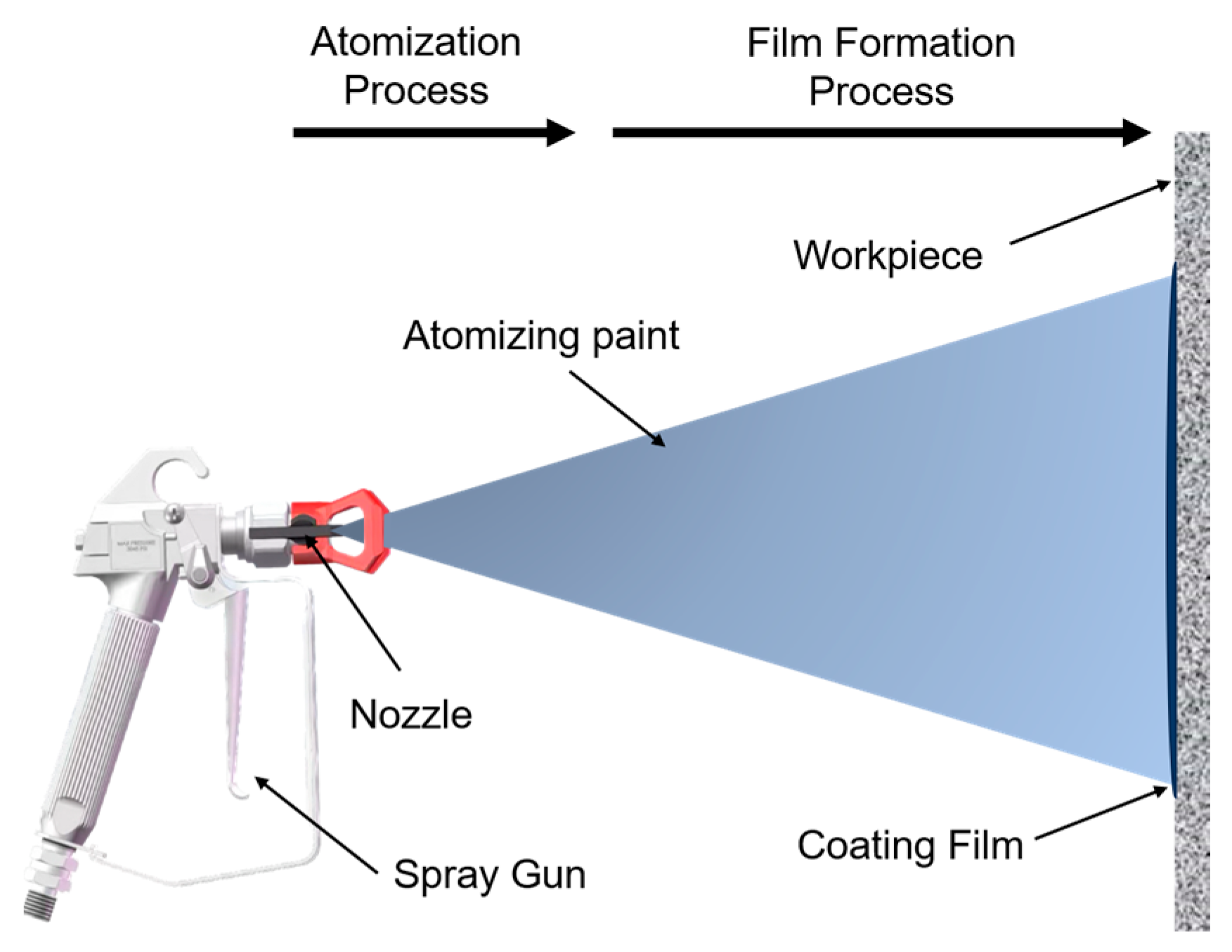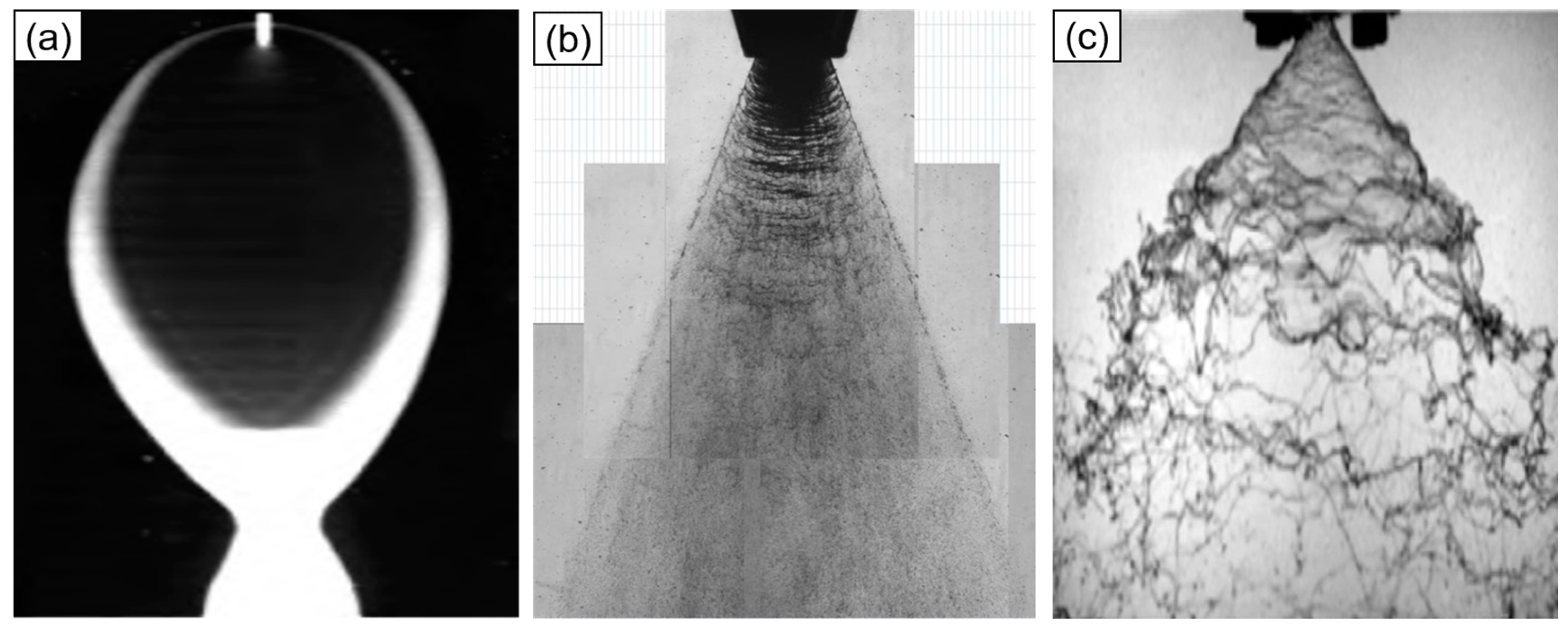
| Version | Summary | Created by | Modification | Content Size | Created at | Operation |
|---|---|---|---|---|---|---|
| 1 | Zhaojie Wu | -- | 2524 | 2023-12-21 18:03:39 | | | |
| 2 | Jessie Wu | -3 word(s) | 2521 | 2023-12-22 07:36:48 | | |
Video Upload Options
The special surface appearance of complex surfaces restricts the coating film quality of spraying. The study of the atomization and film formation characteristics of typical complex surfaces, as well as the spraying mechanism, is essential for planning the spraying robotic trajectory and improving the spraying efficiency. Modeling and characteristics of the atomization and film formation process, based on CFD numerical simulations in previous studies, are systematically reviewed, focusing especially on airless spraying. In addition, the advantages and disadvantages of the existing research from the perspective of numerical models and methods are discussed. Finally, a further research direction for spraying on complex surface is prospected. Overall, a comprehensive and up-to-date review of spray atomization and film formation characteristics is considered valuable to practitioners and researchers in these fields, and will facilitate the further application of robotic spraying in the mechanical, automotive, marine, aerospace, petrochemical and other industries.
1. Introduction

2. Historical Overview of Paint Atomization Properties and Mechanisms
2.1. Mechanism Study of Atomization in Airless Spraying

2.2. Experimental Study of Atomization in Airless Spraying
3. Historical Overview of Paint Film Formation Properties and Mechanisms
3.1. Mechanism Study of Paint Film Formation in Airless Spraying

3.2. Experimental Study of Paint Film Formation in Airless Spraying
References
- Abualigaledari, S. Development of an Anti-Corrosion Thermally Sprayed Coating System for Oil and Gas Transmission Pipeline; North Dakota State University: Fargo, ND, USA, 2018.
- Cai, S.; Ji, H.; Zhu, F.; Pei, W.; Xiao, W.; Tang, X. Research on the Corrosion Behavior of Q235 Pipeline Steel in an Atmospheric Environment through Experiment. Materials 2022, 15, 6502.
- Akafuah, N.K.; Poozesh, S.; Salaimeh, A.; Patrick, G.; Lawler, K.; Saito, K. Evolution of the Automotive Body Coating Process-A Review. Coatings 2016, 6, 24.
- Thomas, J.; Patil, R.S.; John, J.; Patil, M. A Comprehensive Outlook of Scope within Exterior Automotive Plastic Substrates and Its Coatings. Coatings 2023, 13, 1569.
- Wan, K.; Li, C.; Xing, C.; Zhao, H.; Yu, L. Enhanced Anticorrosion Properties of Epoxy Coatings from Al and Zn Based Pigments. Chem. Res. Chin. Univ. 2015, 31, 573–580.
- Li, X.; Wang, F.; Mao, J. Preparation and properties of thermosetting powder/graphene oxide coatings for anticorrosion application. J. Appl. Polym. Sci. 2019, 136, 48264.
- Kalendova, A.; Kalenda, P.; Vesely, D. Comparison of the efficiency of inorganic nonmetal pigments with zinc powder in anticorrosion paints. Prog. Org. Coat. 2006, 57, 1–10.
- Chen, S.; Chen, Y.; Wu, Z.; Jiang, J.; Li, J.; Hua, W. A Hybrid Euler-Lagrange Model for the Paint Atomization Process of Air Spraying. Processes 2022, 10, 2513.
- Chen, Y.; Chen, S.M.; Chen, W.Z.; Hu, J.; Jiang, J.Z. An Atomization Model of Air Spraying Using the Volume-of-Fluid Method and Large Eddy Simulation. Coatings 2021, 11, 1400.
- Fogliati, M.; Fontana, D.; Garbero, M.; Vanni, M.; Baldi, G.; Donde, R. CFD simulation of paint deposition in an air spray process. JCT Res. 2006, 3, 117–125.
- Pendar, M.R.; Pascoa, J.C. Numerical modeling of electrostatic spray painting transfer processes in rotary bell cup for automotive painting. Int. J. Heat Fluid Flow 2019, 80, 26.
- Seong, B.; Hwang, S.; Jang, H.S.; Lee, H.; Kim, J.; Vu Dat, N.; Cho, D.-H.; Lin, L.; Byun, D. A hybrid aerodynamic and electrostatic atomization system for enhanced uniformity of thin film. J. Electrost. 2017, 87, 93–101.
- Dyshlovenko, S.; Pawlowski, L.; Pateyron, B.; Smurov, I.; Harding, J.H. Modelling of plasma particle interactions and coating growth for plasma spraying of hydroxyapatite. Surf. Coat. Technol. 2006, 200, 3757–3769.
- Wang, F.; Fan, Q.; Wang, L.; Wang, Q.; Ma, Z. Full-Scale Numerical Simulation of Plasma-Sprayed Functionally Gradient Materials. In Proceedings of the 6th International Conference on Materials Processing for Properties and Performance, Beijing, China, 14–16 September 2007; pp. 1–6.
- Zhang, H.; Mauer, G.; Liu, S.; Liu, M.; Jia, Y.; Li, C.; Li, C.; Vassen, R. Modeling of the Effect of Carrier Gas Injection on the Laminarity of the Plasma Jet Generated by a Cascaded Spray Gun. Coatings 2022, 12, 1416.
- Sun, L.; Li, Z.; Liu, L.; Liu, S.; Sun, L.; Yu, G.; Ji, S. Process Improvements in Internal Surface Spraying of Medium and Large Caliber Ammunition. Surf. Technol. 2015, 44, 105–109.
- Yang, G.; Chen, Y.; Chen, S.; Jiang, J. Review on Modeling and Characteristics of Airless Spraying Film. Contemp. Chem. Ind. 2021, 50, 2667–2671+2675.
- Giffen, T.; Muraszew, A. The Atomization of Liquid Fuels; John Wiley and Sons: New York, NY, USA, 1953.
- Castleman, R.A. Mechanism of atomization accompanying Solid injection. J. Frankl. Inst. 1932, 214, 620.
- Dejuhasz, K.J. Dispersion of sprays in solid injection oil engines. J. Fluids Eng. 1931, 53, 65.
- Schweitzer, P.H. Mechanism of Disintegration of Liquid Jets. J. Appl. Phys. 1937, 8, 513–521.
- Tian, C.X.; Qiu, X.Q.; Cui, Y.J. Development of Technology on Atomization. Ind. Heat. 2005, 34, 4.
- Shkadov, V.Y. Wave formation on surface of viscous liquid due to tangential stress. Fluid Dyn. 1970, 5, 473–476.
- Keller, J.B.; Rubinow, S.I.; Tu, Y.O. Spatial instability of a jet. Phys. Fluids 1973, 16, 2052–2055.
- Rayleigh, L. On The Instability Of Jets. Proc. Lond. Math. Soc. 1878, s1-10, 4–13.
- Weber, C. Disintegration of liquid jets. Zangewmathmech 1931, 11, 136–159.
- York, J.L.; Stubbs, H.E.; Tek, M.R. The mechanism of disintegration of liquid sheets. Trans. ASME 1953, 75, 1279–1286.
- Yuan, W.; Huang, Y.; Zhang, H.; Li, L. Experiment on shape and thickness of liquid film formed by impinging jets on solid walls. J. Aerosp. Power 2022, 37, 2524–2533.
- Ye, Q.; Shen, B.; Tiedje, O.; Domnick, J. Investigations of Spray Painting Processes Using an Airless Spray Gun. J. Energ. Eng. 2013, 7, 74–81.
- Squire, H.B. Investigation of the instability of a moving liquid film. Br. J. Appl. Phys. 1953, 4, 167–169.
- Hagerty, W.W.; Shea, J.F. A Study of the Stability of Plane Fluid Sheets. J. Appl. Mech. 2021, 22, 509–514.
- Fraser, R.P.; Eisenklam, P.; Dombrowski, N.; Hasson, D. Drop formation from rapidly moving liquid sheets. AIChE J. 1962, 8, 672–680.
- Dombrowski, N.; Fraser, R.P. A Photographic Investigation into the Disintegration of Liquid Sheets. Philos. Trans. R. Soc. Lond. Ser. A 1954, 247, 101–130.
- Cao, J.; Li, X. Stability of Plane Liquid Sheets in Compressible Gas Streams. J. Propuls. Power 2000, 16, 623–627.
- Cao, J.; Xiong, W.; Li, W.; Zhang, Y. Linear Stability Analysis on Viscous Plane Liquid Film into Compressible Gas Streams. Adv. NR Energy 2018, 6, 490–497.
- Janna, W.S.; John, J.E.A. Drop-Size Distributions of Newtonian and Bingham Liquid Sprays Produced by Fan-Jet Pressure Nozzles With and Without the Preorifice. J. Eng. Ind. 1981, 103, 402–408.
- May, K.R. The Measurement of Airborne Droplets by the Magnesium Oxide Method. J. Sci. Instrum. 1950, 27, 128.
- Teng, Y.; Wang, X.; Sun, Z.S.; Lu, J.P. Experimental Research on Atomizing Characteristics of Paint for High-pressure Airless Spraying. Surf. Technol. 2011, 40, 68–70+100.
- Wang, Y.; Zhang, M.; Wang, Y.; Wen, K.; Zhuo, K.; Guo, R.; Gao, P. Partially Coherent Illumination-Based Digital Holographic Microscopy and Its Applications. Laser Optoelectron. Prog. 2021, 58, 1811005.
- Liu, X.C.; Gao, T.C.; Liu, L.; Zhai, D.L. Research on microphysical property of raindrops basedon particle imaging velocimetry technology. Acta Phys Sin 2014, 63, 469–475.
- Zang, L.Y.; Tian, R.F.; Sun, L.X.; Zhu, M.; Luo, Q. Application of Planar Laser-induced Fluorescence Technique in Measurement of Dynamic Film Thickness. At. Energy Sci. Technol. 2014, 48, 1654–1659.
- Domnick, J.; Scheibe, A.; Ye, Q. The simulation of electrostatic spray painting process with high-speed rotary bell atomizers. Part II: External charging. Part. Part. Syst. Charact. 2007, 23, 408–416.
- Domnick, J.; Scheibe, A.; Ye, Q. The Simulation of the Electrostatic Spray Painting Process with High-Speed Rotary Bell Atomizers. Part I: Direct Charging. Part. Part. Syst. Charact. 2005, 22, 141–150.
- Saffman, M. Automatic calibration of LDA measurement volume size. Appl. Opt. 1987, 26 13, 2592–2597.
- Wang, C.P.; Snyder, D. Laser Doppler velocimetry: Experimental study. Appl. Opt. 1974, 13, 98–103.
- Schaefer, W.; Rosenkranz, S.; Tropea, C. Validation of the Time-Shift Technique for Spray Characterization. In Proceedings of the ILASS Americas 27th Annual Conference on Liquid Atomization and Spray Systems, Raleigh, NC, USA, 18 May 2015.
- Schäfer, W. Time-Shift Technique for Particle Characterization in Sprays; Epubli GmbH: Berlin, Germany, 2013.
- Schäfer, W.; Tropea, C. Time-shift technique for simultaneous measurement of size, velocity, and relative refractive index of transparent droplets or particles in a flow. Appl. Opt. 2014, 53, 588–597.
- Schäfer, W.; Tropea, C. Characterization of Atomization Processes in Suspension/Emulsion Sprays. J. Energy Power Eng. 2016, 10, 223–230.
- Naz, M.Y.; Sulaiman, S.A.; Ariwahjoedi, B.; Shaari, K.Z.K. Visual Characterization of Airless Water Spray Jet Breakup and Vortex Clouds Formation at Elevated Temperature and Pressure. Arab. J. Sci. Eng. 2014, 39, 7241–7250.
- Naz, M.Y.; Sulaiman, S.A.; Ariwahjoedi, B.; Shaari, K.Z.K. Visual Study of Hollow Cone Water Spray Jet Breakup Process at Elevated Temperatures and Pressures. In Proceedings of the 4th International Conference on Mechanical and Manufacturing Engineering (ICME 2013), Bangi Putrajaya, Malaysia, 17–19 December 2013; pp. 485–489.
- Naz, M.Y.; Sulaiman, S.A.; Ariwahjoedi, B.; Shaari, K.Z.K. Visual characterization of heated water spray jet breakup induced by full cone spray nozzles. J. Appl. Mech. Tech. Phys. 2015, 56, 211–219.
- Yarin, A.L. Drop Impact Dynamics: Splashing, Spreading, Receding, Bouncing…. Annu. Rev. Fluid Mech. 2005, 38, 159–192.
- Mc-Carthy, J.E. Basic Studies on Spray Coating: Drop Rebound from a Small Workpiece with a Conventional Air Applicator. MSME Thesis, Purdue University, West Lafayette, IN, USA, 1992.
- Mirko, G.; Marco, V.; Giancarlo, B. CFD modelling of a spray deposition process of paint. Macromol. Symp. 2002, 187, 719–730.
- Stanton, D.W.; Rutland, C.J. Modeling fuel film formation and wall interaction in diesel engines. SAE Trans. 1996, 105, 808–824.
- O’rourke, P.J.; Amsden, A.A. A Spray/Wall Interaction Submodel for the KIVA-3 Wall Film Model. SAE Trans. 2000, 109, 281–298.
- Domnick, J.; Lindenthal, A.; Tropea, C.; Xu, T.H. Application of phase doppler anemometry in paint sprays. At. Sprays 1994, 4, 437–450.
- Ye, Q.; Domnick, J.; Scheibe, A. Simulation of the spray coating process using a pneumatic atomizer. In Proceedings of the ILASS-Europe, Zaragoza, Spain, 11–19 September 2002.
- Xu, X.M. Simulation and Optimum Design of Container Automatic Spraying. Master’s Thesis, South China University of Technology, Guangzhou, China, 2015.
- Plesniak, M.W.; Sojka, P.E.; Singh, A.K. Transfer efficiency for airless painting systems. JCT Res. 2004, 1, 137–145.
- Teng, Y.; Wang, X.; Li, X. Main Influencing Factors and Laws on Transfer Efficiency of Paint for High-pressure Airless Spraying. Corros. Prot. 2012, 33, 753–756.
- Chen, Y.; Chen, W.; Chen, K.; Li, B. Motion Planning of Redundant Manipulators for Painting Uniform Thick Coating in Irregular Duct. J. Robot. 2016, 2016, 1–12.
- Poozesh, S.; Akafuah, N.; Saito, K. Effects of automotive paint spray technology on the paint transfer efficiency—A review. Proc. Inst. Mech. Eng. Part D 2017, 232, 282–301.




